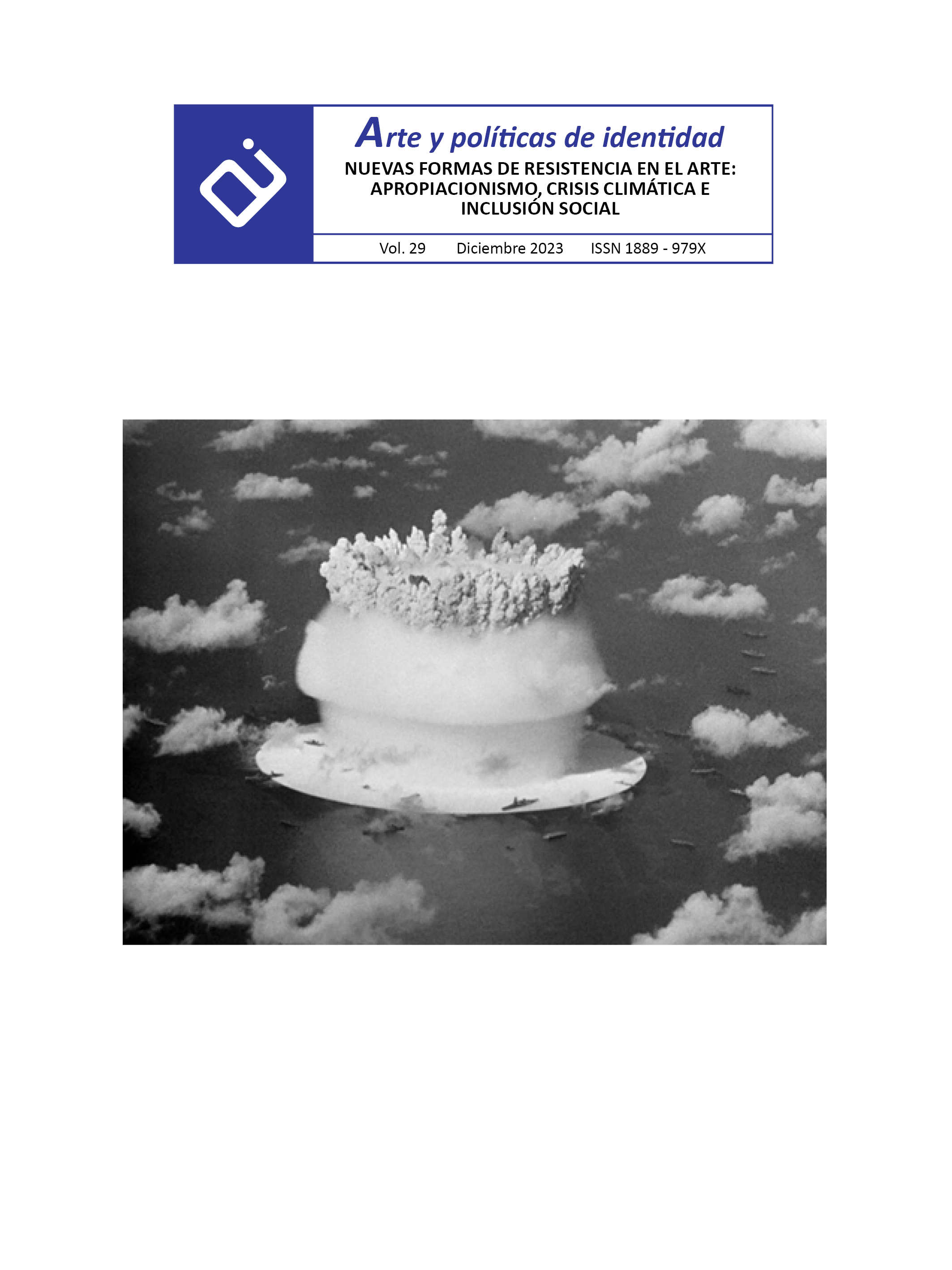Hackear el sistema operativo del arte: nuevas formas de resistencia al trabajo en Strike (2010) de Hito Steyerl
Resumen
El siguiente ensayo se centra en el ámbito digital para examinar el modelo de trabajo en la Nueva Economía, investigando cómo la tecnología y sus mecanismos de vigilancia generan y explotan subjetividad. Para ello, reconsidero la obra de Hito Steyerl Strike (2010) como una llamada a subvertir el poder biopolítico de las tecnologías de la información. Mi análisis de la obra de Steyerl busca desvelar las implicaciones sociales y materiales de lo tecnológico, el trabajo no remunerado que sustenta Internet y el sistema de dominación ejercido por el capitalismo de la vigilancia, que se lucra con el tráfico de datos y la modificación de la conducta. Frente a esto, sostengo que Strike (2010) propone una reapropiación de la máquina como forma de huelga. Así, la pieza de vídeo de Steyerl sirve como punto de partida para rastrear prácticas artísticas intervencionistas que, a través del tactical media y el hacking, tratan de invertir los mecanismos de vigilancia de la red, revelando su potencial como gestos de disidencia dentro de un mundo del arte cada vez más informatizado.
Descargas
-
Resumen352
-
pdf408
Citas
Alter, N. M. (2007). Translating the Essay into Film and Installation. Journal of Visual Culture, 6(1), 44-57. https://doi.org/10.1177/1470412907075068
Bastani, A. (2019). Fully automated luxury communism: A manifesto. Verso Books.
Colomina, B. (2014). The century of the bed. In Colomina, B., Ruhs, A., & Rumpfhuber, A. (Ed.) The Century of the Bed. Museum Moderner Kunst Stiftung Ludwig Wien.
Crary, J. (2013). 24/7: Late capitalism and the ends of sleep. Verso Books.
Critical Art Ensemble (Ed.). (2001). Digital Resistance: Explorations in tactical media. Autonomedia.
Federici, S. (2012). Revolution at point zero: Housework, reproduction, and feminist struggle. PM Press.
Foucault, M. (1990). The History of Sexuality: Volume 1. Vintage books.
Foucault, M. (1999). Michel Foucault: Estética, ética y hermenéutica. Paidós.
Foucault, M. (2003). The Essential Foucault: Selections from Essential Works of Foucault, 1954-1984. New Press.
Friis, J. (2021). Negotiations of in/visibility: Surveillance in Hito Steyer’s How Not to be Seen. Surveillance & Society, 19(1). 69-80.
Gamboni, D. (1997). The destruction of art: Iconoclasm and vandalism since the French Revolution. Yale University Press.
Goodkind, A. L., Jones, B. A., & Berrens, R. P. (2020). Cryptodamages: Monetary value estimates of the air pollution and human health impacts of cryptocurrency mining. Energy Research & Social Science, 59, 101281.
https://doi.org/10.1016/j.erss.2019.101281
Holmes, B. (2008). Unleashing the collective phantoms: Essays in reverse imagineering. Autonomedia.
Kracauer, S. (1969). History, the last things before the last. Oxford University Press.
Kraynak, J. (2020). Contemporary Art and the Digitization of Everyday Life. University of California Press.
Lazzarato, M. (1996). Immaterial Labor. In Virno, p & Hardt, M. (Ed.) (1996). Radical Thought in Italy: A Potential Politics, vol. v. 7, University of Minnesota Press.
Lazzarato, M. (2004). Les révolutions du capitalisme. Empecheurs de Penser en Rond.
Magagnoli, P. (2013). Capitalism as Creative Destruction: The Representation of the Economic Crisis in Hito Steyerl’s In Free Fall. Third Text, 27(6), 723-734.
Maxigas. (2017). Hackers against technology: Critique and recuperation in technological cycles. Social Studies of Science, 47(6), 841–860.
Mueller, G. (2021). Breaking Things at Work: The Luddites Are Right About Why You Hate Your Job. Verso Books.
Negri, T & Hardt, M. (2000). Empire. Harvard University Press.
Raley, R. (2009). Tactical media. University of Minnesota Press.
Rancière, J. (2000). Le partage du sensible: esthétique et politique. La fabrique éditions.
Rancière, J. (2012). El malestar en la estética. Clave Intelectual.
Scholz, T. (Ed.). (2013). Digital labor: The Internet as playground and factory. Routledge.
Spieker, S. (Ed.). (2017). Destruction. Whitechapel Gallery, The MIT Press.
Stallman, R. (2002). Free software, free society: Selected essays of Richard M. Stallman. Lulu.com.
Steyerl, H. (2009). Is a Museum a Factory? E-Flux Journal. Disponible en https://www.e-flux.com/journal/07/61390/is-a-museum-a-factory/
Steyerl, H (2010) Politics of Art: Contemporary Art and the Transition to Post-Democracy. E-Flux Journal. Disponible en https://www.e-flux.com/journal/21/67696/politics-of-art-contemporary-art-and-the-transition-to-post-democracy/
Steyerl, H. (2012). The Wretched of the Screen. Sternberg Press.
Steyerl, H. (2013) Too Much World: Is the Internet Dead? E-Flux Journal. Disponible en https://www.e-flux.com/journal/49/60004/too-much-world-is-the-internet-dead/
Steyerl, H. (2017). Duty free art. Verso.
Stiles, K. (2016). Concerning consequences: Studies in art, destruction, and trauma. The University of Chicago Press.
Tapscott, D. (1996). The digital economy: Promise and peril in the age of networked intelligence (Vol. 1). McGraw-Hill New York.
Terranova, T. (2004). Network culture: Politics for the information age. Pluto Press.
Wark, M. (2004). Hacker-Manifest. CH Beck. Disponible en https://monoskop.org/images/8/85/Wark_McKenzie_A_Hacker_Manifesto.pdf
Zafra, R. (2017). El entusiasmo. Precariedad y trabajo creativo en la era digital. Anagrama.
Zook, M., & Graham, M. (2018). Hacking code/space: Confounding the code of global capitalism. Transactions of the Institute of British Geographers, 43(3), 390–404.
Zuboff, S. (1988). In the age of the smart machine: The future of work and power. Basic Books, Inc.
Zuboff, S. (2019). The age of surveillance capitalism: The fight for a human future at the new frontier of power. Profile books.
Derechos de autor 2023 Servicio de Publicaciones de la Universidad de Murcia

Esta obra está bajo una licencia internacional Creative Commons Atribución-NoComercial-SinDerivadas 4.0.
Works published in this journal are subject to the following terms:
- The Service of Publications from the University of Murcia (publishing house) keeps the published works’ copyrights, and favors and allows the reuse of these works under the license indicated in point 2.
- Works are published in the journal’s online edition under the license Creative Commons Reconocimiento-NoComercial-SinObraDerivada 3.0 España(texto legal). They can be copied, used, disseminated, transmitted and publicly exhibited, as long as: i) the author and original source of publication are cited (journal, publishing house and work’s URL); ii) they are not used for commercial purposes; iii) the existence and specifications of this license are mentioned.
3. Conditions for auto-file. It is allowed and encouraged that authors share electronically their pre-print version (the pre-reviewed version) and /or post-print version (the reviewed and accepted version) of their Works before the publication, since it promotes its circulation and dissemination. RoMEO color: green.










